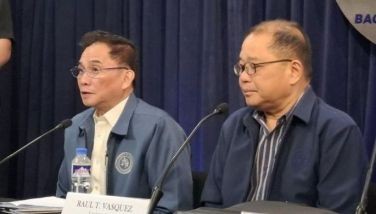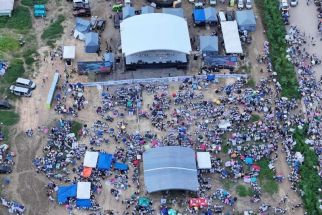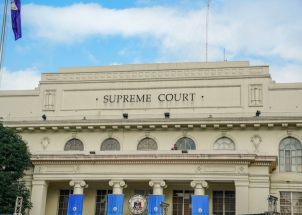Autopsy confirms Julia’s head blows
April 22, 2007 | 12:00am
US Peace Corps volunteer Julia Campbell died from severe beatings to the head, mostly to her face and to the top of her head, medico-legal examinations on her remains show.
Campbell’s injuries only bolstered earlier speculations that she was bludgeoned by her killer, whom police are now hunting down in Ifugao and nearby provinces.
"The cause of death involves multiple blunt traumatic injuries of the head. Trauma was mostly at the head. Most at the front and on the top of it," PNP Crime Laboratory medico-legal officer Chief Inspector Mamerto Bernabe, who headed the autopsy on Campbell’s remains, declared in a media briefing at the Loyola Memorial Chapels.
Bernabe said the nature of the injuries indicate a very strong possibility that the 40-year-old Fairfax, Virginia native, was indeed bludgeoned to death.
Post-mortem medical examinations can determine the cause of death, making the procedure highly significant to any legal proceeding, especially in the absence of direct eyewitnesses.
In Campbell’s case, the police have already tagged a suspect but have yet to effect an arrest in the absence of material and scientific evidence.
"This only means that her death wasn’t an accident," Crime Laboratory head Chief Superintendent Arturo Cacdac said.
Cacdac added Campbell’s arms also were injured, indicating that she tried to block off the blows.
"During the debriefing, the US experts concurred with our own experts, " he said.
Several US Peace Corps volunteers, along with US pathologists, were around to witness and oversee the six-hour procedure.
Cacdac said a full report will be submitted to PNP chief Director General Oscar Calderon. It may take up to three weeks to obtain results from DNA test on samples taken from "critical" parts of Campbell’s body, including her fingernails, he added.
Campbell’s remains were immediately turned over to the Peace Corps after the autopsy, which was observed by US forensic experts.
Calderon told The STAR the full report surrounding the incident would be known in seven days when the Crime Laboratory technicians submit their findings to him.
"For now, it’s very hard to speculate but from all indications, there was foul play. But in fairness to the family of the victim, they should be the first to know what really happened," he said.
Calderon theorized that Campbell might have put up a fight with her attacker.
Calderon expressed doubts that Campbell had been sexually molested before she was killed. But he could not completely rule this out as he has yet to read the official report.
Calderon revealed that they already have several witnesses, mostly minors, who saw the suspect carrying the missing backpack of Campbell.
He said the local police also recovered several pieces of material evidence from the suspect’s residence, including a bloodied piece of wood and bloodstained pants.
"Siya ang aming suspect dahil simula ng mawala si Miss Campbell ay hindi na siya umuwi at nakita pa ito ng ilang grupo ng mga kabataan na dala-dala niya ang nawawalang backpack ni Miss Campbell (He is our suspect because since Miss Campbell went missing, he stopped going home and he was last seen by several youths carrying the missing backpack of Ms. Campbell)," Calderon told The STAR.
The suspect has been identified as the husband of the woman who sold Campbell a Coca-Cola before she proceeded with her hike in the remote area – a World Heritage site – in Ifugao province, about 260 kilometers north of Manila.
The woman, however, told GMA-7 that her husband was not in Battad at the time of Campbell’s disappearance.
The police would also process the photographs from Campbell’s camera.
The camera was among the pieces of material evidence the police have recovered from Campbell.
Cordillera Administrative Region (CAR) police director Chief Superintendent Raul Gonzales said the autopsy showed whoever was responsible "made sure she was dead."
He added that the police are going very carefully in their investigation in the Campbell case to build an airtight case against the suspect.
He said he has dispatched several teams of police intelligence agents to track down the suspect who has since failed to return home after Campbell’s body was recovered in Barangay Battad.
Meanwhile, tribal chieftains in Banaue, especially those in the underlying areas of Battad, have been organizing trackers in search for the suspect.
"I was informed that the tribesmen are now angry at the suspect. Kasi itong mga tribong ito ay kumikita sa mga turistang bumibisita sa Barangay Battad. Dahil sa insidente, ang tingin nila ay pinutulan din sila ng hanapbuhay ng suspect (These tribes earn their living from the tourists who visit Barangay Battad. Because of this incident, they believe that the suspect have cut off their means of livelihood)," Calderon said.
The last procedure the PNP Crime Laboratory experts would be performing on Campbell would be reconstruction wherein they would try to bring back her body to its old form.
Cacdac said that after these procedures have been completed, Campbell’s body will not be returned to Camp Crame but will be shipped to her family in the United States as arranged by the US Embassy.
Copies of the report will also be forwarded to the Cordillera Administrative Region (CAR) regional police office as well as the Ifugao provincial police office.
"They are the end-users of this report," said Cacdac, referring to the ongoing local police case build-up against the suspect.
The PNP is also putting up a Police Community Precinct (PCP) in Barangay Battad as Calderon ordered heightened police watch in the area to ensure the safety of foreign and local tourists visiting the place.
"We are putting up a PCP in Barangay Battad for us to be able to ensure the safety of tourists," Gonzales said, adding that police patrol in the area has been intensified to deter crime groups from molesting visitors. - With AP
Campbell’s injuries only bolstered earlier speculations that she was bludgeoned by her killer, whom police are now hunting down in Ifugao and nearby provinces.
"The cause of death involves multiple blunt traumatic injuries of the head. Trauma was mostly at the head. Most at the front and on the top of it," PNP Crime Laboratory medico-legal officer Chief Inspector Mamerto Bernabe, who headed the autopsy on Campbell’s remains, declared in a media briefing at the Loyola Memorial Chapels.
Bernabe said the nature of the injuries indicate a very strong possibility that the 40-year-old Fairfax, Virginia native, was indeed bludgeoned to death.
Post-mortem medical examinations can determine the cause of death, making the procedure highly significant to any legal proceeding, especially in the absence of direct eyewitnesses.
In Campbell’s case, the police have already tagged a suspect but have yet to effect an arrest in the absence of material and scientific evidence.
"This only means that her death wasn’t an accident," Crime Laboratory head Chief Superintendent Arturo Cacdac said.
Cacdac added Campbell’s arms also were injured, indicating that she tried to block off the blows.
"During the debriefing, the US experts concurred with our own experts, " he said.
Several US Peace Corps volunteers, along with US pathologists, were around to witness and oversee the six-hour procedure.
Cacdac said a full report will be submitted to PNP chief Director General Oscar Calderon. It may take up to three weeks to obtain results from DNA test on samples taken from "critical" parts of Campbell’s body, including her fingernails, he added.
Campbell’s remains were immediately turned over to the Peace Corps after the autopsy, which was observed by US forensic experts.
Calderon told The STAR the full report surrounding the incident would be known in seven days when the Crime Laboratory technicians submit their findings to him.
"For now, it’s very hard to speculate but from all indications, there was foul play. But in fairness to the family of the victim, they should be the first to know what really happened," he said.
Calderon theorized that Campbell might have put up a fight with her attacker.
Calderon expressed doubts that Campbell had been sexually molested before she was killed. But he could not completely rule this out as he has yet to read the official report.
Calderon revealed that they already have several witnesses, mostly minors, who saw the suspect carrying the missing backpack of Campbell.
He said the local police also recovered several pieces of material evidence from the suspect’s residence, including a bloodied piece of wood and bloodstained pants.
"Siya ang aming suspect dahil simula ng mawala si Miss Campbell ay hindi na siya umuwi at nakita pa ito ng ilang grupo ng mga kabataan na dala-dala niya ang nawawalang backpack ni Miss Campbell (He is our suspect because since Miss Campbell went missing, he stopped going home and he was last seen by several youths carrying the missing backpack of Ms. Campbell)," Calderon told The STAR.
The suspect has been identified as the husband of the woman who sold Campbell a Coca-Cola before she proceeded with her hike in the remote area – a World Heritage site – in Ifugao province, about 260 kilometers north of Manila.
The woman, however, told GMA-7 that her husband was not in Battad at the time of Campbell’s disappearance.
The police would also process the photographs from Campbell’s camera.
The camera was among the pieces of material evidence the police have recovered from Campbell.
Cordillera Administrative Region (CAR) police director Chief Superintendent Raul Gonzales said the autopsy showed whoever was responsible "made sure she was dead."
He added that the police are going very carefully in their investigation in the Campbell case to build an airtight case against the suspect.
He said he has dispatched several teams of police intelligence agents to track down the suspect who has since failed to return home after Campbell’s body was recovered in Barangay Battad.
Meanwhile, tribal chieftains in Banaue, especially those in the underlying areas of Battad, have been organizing trackers in search for the suspect.
"I was informed that the tribesmen are now angry at the suspect. Kasi itong mga tribong ito ay kumikita sa mga turistang bumibisita sa Barangay Battad. Dahil sa insidente, ang tingin nila ay pinutulan din sila ng hanapbuhay ng suspect (These tribes earn their living from the tourists who visit Barangay Battad. Because of this incident, they believe that the suspect have cut off their means of livelihood)," Calderon said.
The last procedure the PNP Crime Laboratory experts would be performing on Campbell would be reconstruction wherein they would try to bring back her body to its old form.
Cacdac said that after these procedures have been completed, Campbell’s body will not be returned to Camp Crame but will be shipped to her family in the United States as arranged by the US Embassy.
Copies of the report will also be forwarded to the Cordillera Administrative Region (CAR) regional police office as well as the Ifugao provincial police office.
"They are the end-users of this report," said Cacdac, referring to the ongoing local police case build-up against the suspect.
The PNP is also putting up a Police Community Precinct (PCP) in Barangay Battad as Calderon ordered heightened police watch in the area to ensure the safety of foreign and local tourists visiting the place.
"We are putting up a PCP in Barangay Battad for us to be able to ensure the safety of tourists," Gonzales said, adding that police patrol in the area has been intensified to deter crime groups from molesting visitors. - With AP
BrandSpace Articles
<
>
- Latest
- Trending
Trending
Latest
Trending
Latest
Recommended
January 13, 2025 - 12:00am
































